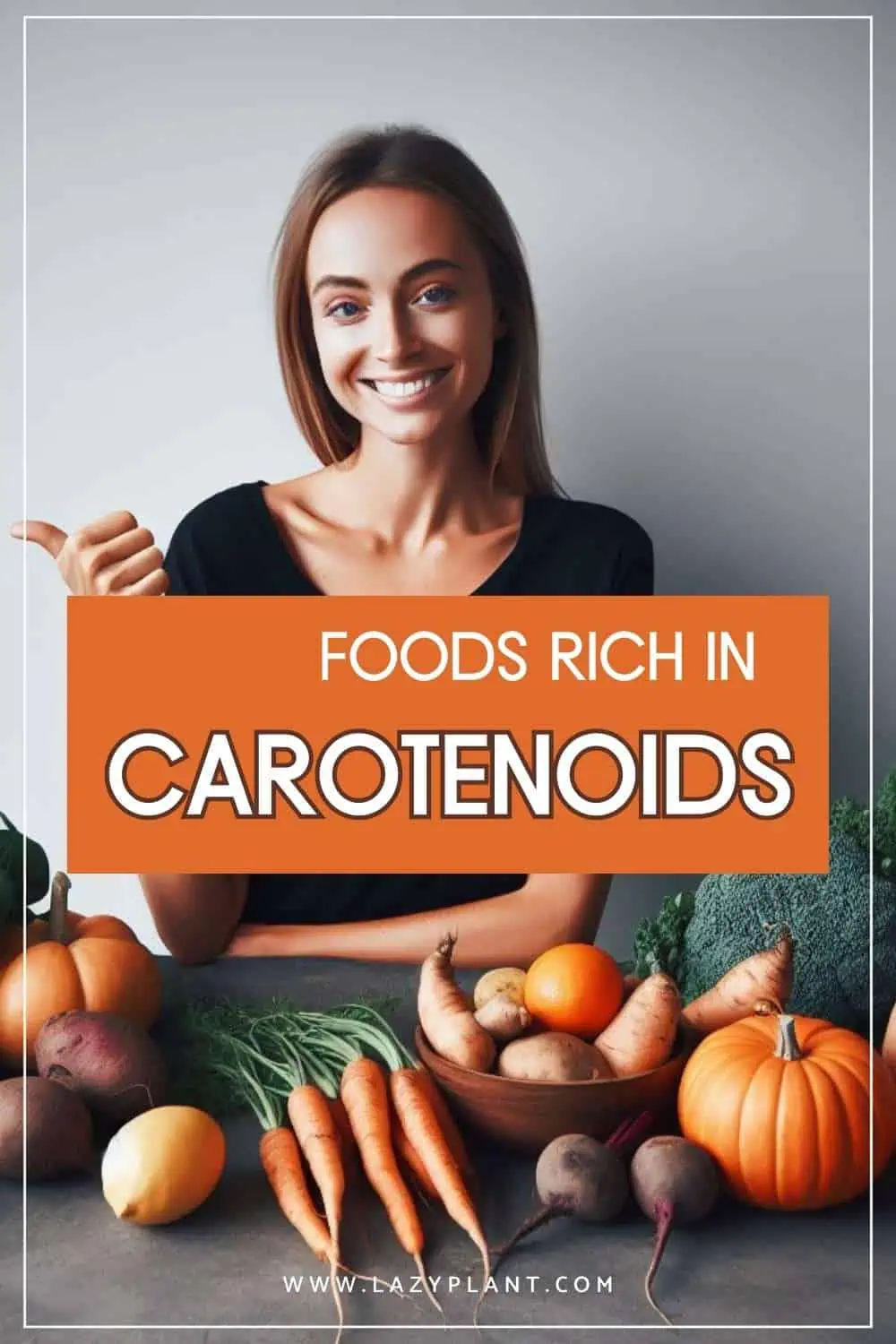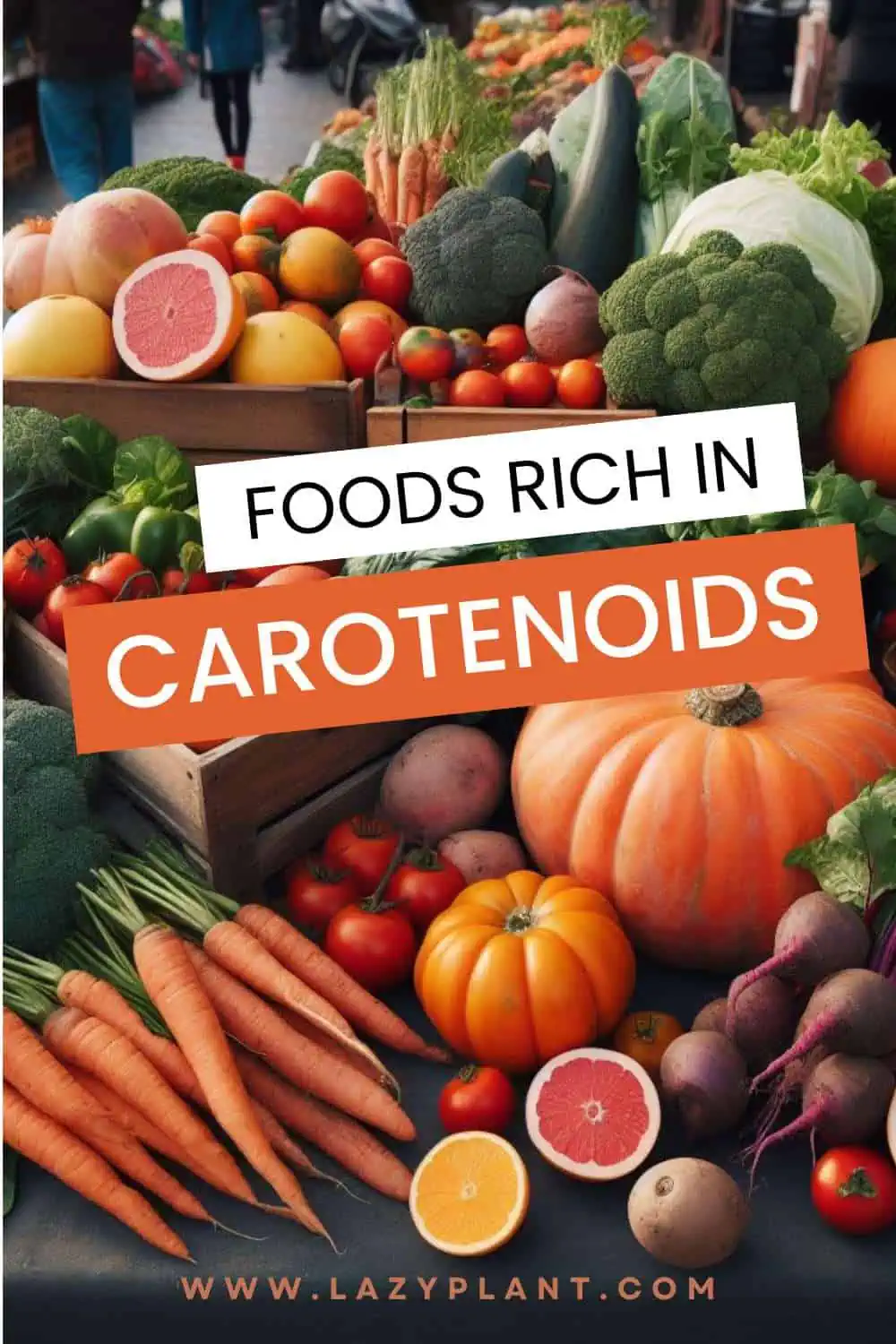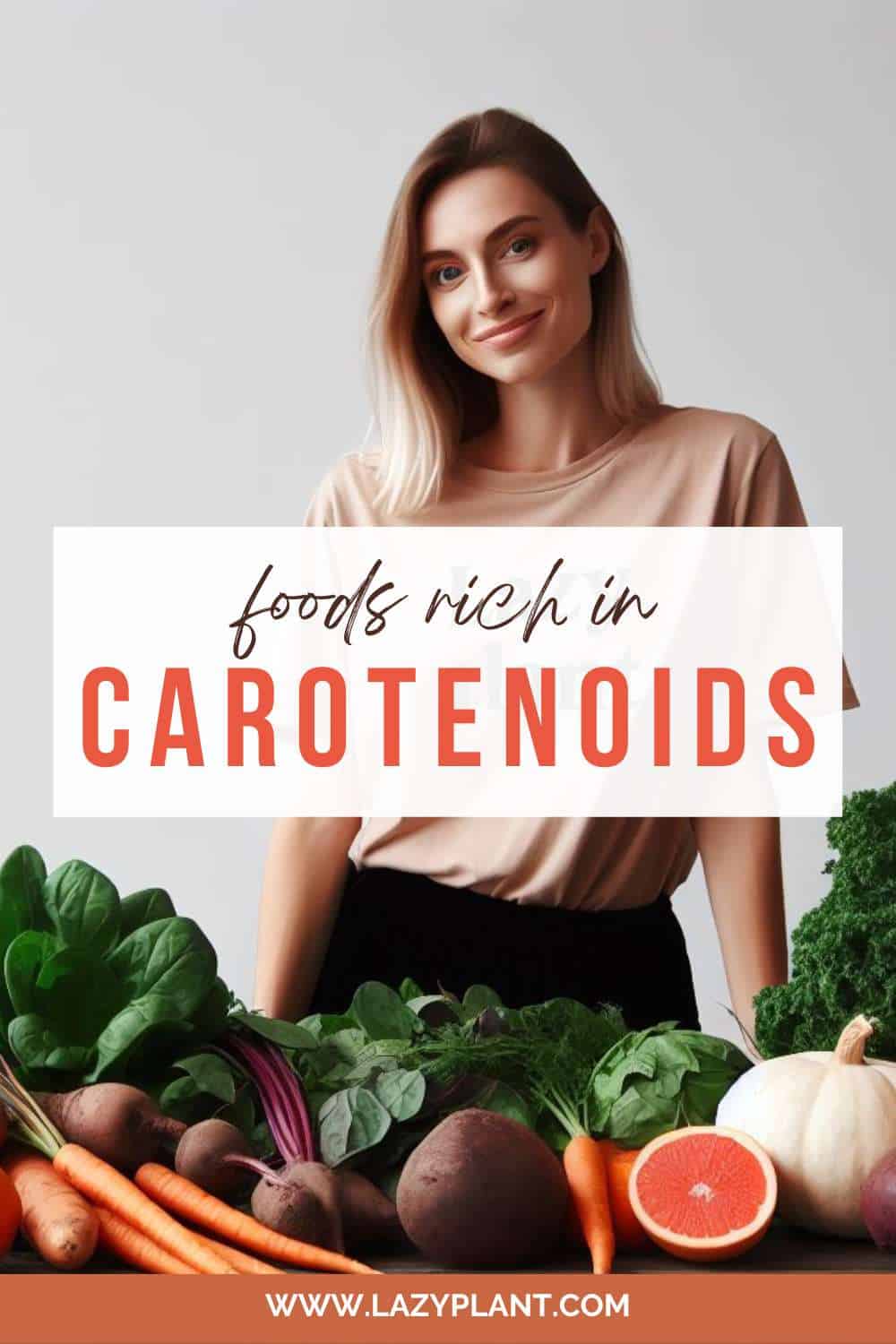Among the richest foods in carotenoids are carrots, spinach, sweet potatoes, turnip, dandelion, collard, beet, and chicory greens. They’re particularly rich in beta-carotene, lutein, and zeaxanthin. Moringa powder has the highest concentrations, though.
What are carotenoids?
Carotenoids are a group of pigments responsible for the vibrant colors in many fruits and vegetables. A diet rich in carotenoids is particularly beneficial for our health, as they have potent antioxidant properties.
The main types of carotenoids include:
- beta-carotene: Found mainly in carrots, sweet potatoes, pumpkins, and various green leafy vegetables, beta-carotene is a precursor to vitamin A. Beta-carotene is twice as bioactive as alpha-carotene.
- alpha-carotene: Similar to beta-carotene, alpha-carotene is also a precursor to vitamin A. It is found in carrots, sweet potatoes, and certain green leafy vegetables.
- lutein: Present abundant in green leafy vegetables such as spinach, kale, and collard greens, lutein is essential for eye health and is part of the macular pigment in the retina. Carotenoids can reduce the risk of chronic eye diseases, such as age-related macular degeneration and cataracts.[1]
- zeaxanthin: Often found alongside lutein in green leafy vegetables and some fruits, zeaxanthin is also crucial for eye health, particularly in preventing age-related macular degeneration.
- lycopene: Commonly found in red and pink fruits such as tomatoes, watermelon, guava, papaya, and pink grapefruit. Most people get high amounts of lycopene from tomato products, as lycopene is destroyed by the heat.
- cryptoxanthin: It’s also a precursor to vitamin A. Citrus fruits, peaches, and apricots are good dietary sources.
- Astaxanthin: It’s found in certain seafood and algae.
- beta-cryptoxanthin: This carotenoid is found in fruits like oranges, peaches, and papayas.
Actually, foods contain a variety of carotenoids. Different fruits and vegetables often have a combination of carotenoids, each contributing to the food’s nutritional profile.
For example, carrots contain beta-carotene, but they may also contain alpha-carotene as well as other carotenoids.
Eating a diverse range of colorful fruits and vegetables is a good way to ensure a mix of various carotenoids in your diet.

Foods high in beta-carotene
There are many other carotenoids in foods, but beta-carotene is the most popular and well-studied. The human body converts beta-carotene to vitamin A.
Many fruits and vegetables are good dietary sources of beta-carotene.
Carrots, spinach, sweet potatoes, turnip greens, dandelion greens, beet greens, and chicory greens are the richest common foods in beta-carotene.
Also, spices and herbs are packed with this crucial carotenoid.
| Vegetables | beta-carotene (mg per 100g) | Spices | beta-carotene (mg per 100g) |
| moringa powder | 28.5 | cayenne pepper | 21.8 |
| grape leaves | 16.2 | chili pepper | 15 |
| sweet potato | 9 | marjoram | 4.8 |
| carrots | 8.3 | sage | 3.5 |
| turnip greens | 7 | coriander leaf, dried | 3.4 |
| dandelion greens | 5.9 | thyme, dried | 2.3 |
| spinach | 5.6 | parsley dried | 1.2 |
| beet greens | 3.8 | ||
| Swiss chard | 3.6 | ||
| chicory greens | 3.4 | ||
| romaine lettuce | 3.3 | ||
| pumpkin | 3.1 | ||
| basil | 3.1 | ||
| collard greens | 3 | ||
| kale | 2.9 | ||
| bok choy | 2.7 | ||
| chives | 2.6 | ||
| melons cantaloupe | 2 | ||
| watercress | 1.9 | ||
| mustard greens | 1.8 | ||
| red sweet pepper | 1.6 | ||
| apricots | 1.1 | ||
| winter squash | 0.8 | ||
| red cabbage | 0.7 | ||
| mango | 0.64 | ||
| onion young leaves | 0.6 |

Foods rich in lutein & zeaxanthin
Lutein and zeaxanthin are also powerful carotenoids, found naturally in plants.
Dandelion, turnip, collard, and chicory greens are the richest common foods in lutein and zeaxanthin. Basil, summer squash, pumpkin, and dried tomatoes are also excellent natural sources!
| Vegetables | Lutein & zeaxanthin (mcg per 100g) | Spices | Lutein & zeaxanthin (mcg per 100g) |
| moringa powder | 41,500 | cayenne pepper | 13,157 |
| dandelion greens | 13,610 | parsley dried | 2,428 |
| turnip greens | 12,825 | coriander leaf, dried | 2,428 |
| Swiss chard | 11,000 | marjoram | 1,895 |
| chicory greens | 10,300 | sage | 1,895 |
| watercress | 5,767 | thyme, dried | 1,895 |
| basil | 5,640 | chili | 310 |
| collard greens | 4,323 | ||
| mustard greens | 3,730 | ||
| summer squash | 2,125 | ||
| grape leaves | 1,747 | ||
| Brussels Sprouts | 1,590 | ||
| beetroot leaves | 1,503 | ||
| pumpkin | 1,500 | ||
| dried tomatoes | 1,419 | ||
| pistachios | 1,160 | ||
| onion young leaves | 1,137 | ||
| broccoli | 745 | ||
| paprika | 651 |
Which is the richest food in carotenoids?
Moringa powder is the richest dietary source of beta-carotene, lutein and zeaxanthin.
In fact, moringa powder is one of the healthiest foods you can eat daily. Above all, it’s pretty high in calcium, protein, and chlorophyll.
How can I consume moringa powder for increased carotenoid intake?
Moringa powder is a versatile ingredient that can be incorporated into your diet in various ways.
Keep in mind that it has a unique taste that can be described as earthy and slightly bitter. It reminds the taste of matcha. Some people may find it to have a mild peppery or nutty undertone.
The flavor profile of moringa powder can vary slightly depending on the quality of the powder and how it’s processed.

If you’re new to moringa, you might want to start with small amounts and gradually incorporate it into your diet to get accustomed to the flavor.
The taste of moringa powder can be easily masked or complemented by blending it into smoothies, mixing it with flavorful ingredients in recipes, or adding sweeteners like honey or fruits.
Here are some common ways to consume moringa powder:
- Smoothies: Add a teaspoon or two of moringa powder to your favorite fruit or vegetable smoothie for a nutrient boost.
- Juices: Mix moringa powder into fresh fruit or vegetable juices for an extra dose of carotenoids.
- Tea: Brew a moringa tea by adding the powder to hot water. You can enhance the flavor with honey or lemon.
- Soups: Sprinkle moringa powder into soups for a healthy meal packed with carotenoids and other antioxidant compounds.
- A quick tip: add moringa powder towards the end of cooking to preserve carotenoids and other nutrients. Most carotenoids are sensitive to heat and can degrade during cooking. Only lutein and zeaxanthin tend to withstand moderate cooking temperatures.
- Salads: Mix moringa powder into salad dressings.
Remember to start with a small amount and gradually increase as you get used to the taste.
If you find the taste too strong, you can also take moringa in the form of capsules or tablets.
You can buy organic moringa powder on iHerb.
It’s also advisable to consult with a healthcare professional, especially if you have any underlying health conditions or are taking medications.
What’s the recommended daily intake for carotenoids?
There is no specific recommended daily intake for carotenoids as a group.
However, according to the American Academy of Ophthalmology, we can slow the progression of eye diseases, such as age-related macular degeneration, if we consume daily 10,000 mcg of lutein and 2,000 mcg of zeaxanthin. There hasn’t been established a recommended daily intake for beta-carotene.[3]
Furthermore, many studies showed great results in maintaining eye health, when participants consumed lutein and zeaxanthin in the range of 6 to 20 mg per day.

The recommended daily intake of carotenoids can vary depending on many factors, though, such as age, sex, health status, and individual needs.
Instead of specifying a particular quantity of carotenoids, it is more common to focus on consuming a diverse and colorful array of fruits and vegetables to ensure an adequate intake of various carotenoids, which also supports good health and well-being.
Also, you could consult a registered dietitian to determine your specific dietary needs based on your individual health and lifestyle factors.